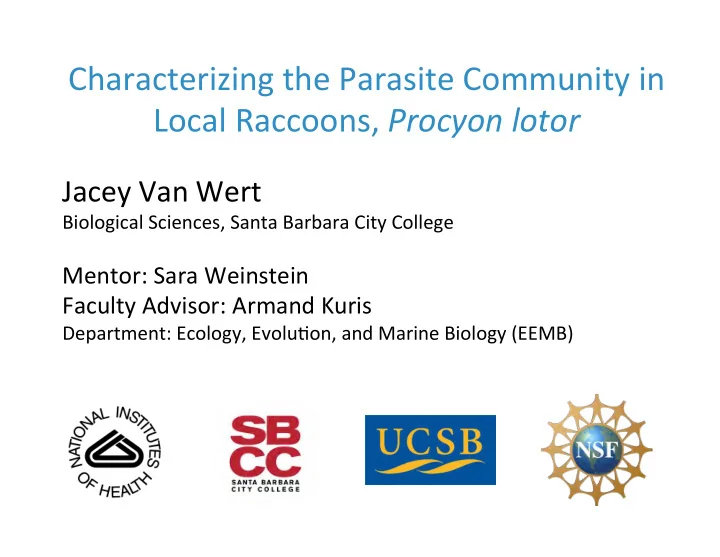

Characterizing ¡the ¡Parasite ¡Community ¡in ¡ Local ¡Raccoons, ¡ Procyon ¡lotor ¡ Jacey ¡Van ¡Wert ¡ Biological ¡Sciences, ¡Santa ¡Barbara ¡City ¡College ¡ Mentor: ¡Sara ¡Weinstein ¡ Faculty ¡Advisor: ¡Armand ¡Kuris ¡ Department: ¡Ecology, ¡EvoluCon, ¡and ¡Marine ¡Biology ¡(EEMB) ¡ ¡
Parasites ¡are ¡everywhere… ¡ Parasite ¡-‑ ¡organism ¡that ¡either ¡harms ¡or ¡lives ¡at ¡the ¡expense ¡ of ¡another ¡organism, ¡the ¡host ¡ ¡ ¡ ZoonoCc ¡Disease ¡ Raccoon ¡Parasites: ¡ ¡ • Abundant ¡ Transfer ¡of ¡disease ¡from ¡ • Within ¡close ¡contact ¡ animal ¡to ¡human ¡ • Dangerous ¡ • Majority ¡of ¡human ¡ i.e. ¡Raccoon ¡ diseases ¡are ¡of ¡ roundworm ¡ à ¡ zoonoCc ¡origin ¡ neurological ¡ • all ¡humans ¡are ¡ suscepCble ¡ ¡ disease ¡ • all ¡regions ¡of ¡the ¡ world ¡sustain ¡parasiCc ¡ species ¡ hRp://www.clermontanimal.net/PetParasites.html ¡ Goal: ¡Understand ¡parasite ¡lifecycle ¡ à à ¡Prevent ¡disease ¡transmission ¡ ¡
Understanding ¡Parasite ¡CommuniCes ¡ Gut ¡parasites ¡ QuesCons: ¡ § What ¡is ¡the ¡parasite ¡ community? ¡ § Is ¡there ¡a ¡relaConship ¡ between ¡locaCon ¡and ¡ parasite ¡presence? ¡ ¡ ¡i.e. ¡beach, ¡woods, ¡urban ¡ Determine ¡distribuCon ¡paRern ¡ ¡ à ¡Predict ¡and ¡prevent ¡disease ¡
Methods: ¡Parasite ¡SorCng ¡& ¡IdenCfying ¡ Collect ¡ Dissect ¡ • Raccoon ¡physical ¡ characterisCcs, ¡health ¡condiCon ¡ • Kill ¡& ¡preserve ¡parasites ¡with ¡ ethanol ¡and ¡> ¡63°C ¡heat ¡ • Raccoon ¡locaCon: ¡longitude/laCtude ¡ Sort, ¡Count, ¡ Iden<fy ¡ Spiny-‑Headed ¡ Worm ¡ • Record ¡and ¡ count ¡ parasite ¡ Tapeworm ¡ Roundworm ¡ species ¡ DissecCng ¡or ¡Compound ¡ Fluke ¡ Scalebar= ¡500 ¡um ¡ Microscope ¡
Constraints ¡and ¡Challenges ¡ hRp://web.stanford.edu ¡ Scalebar= ¡500 ¡um ¡ Dangerous ¡diseases: ¡rabies, ¡ IdenCficaCon ¡ raccoon ¡roundworm ¡ ¡ ¡ Good ¡esCmate ¡ of ¡raccoon ¡ home ¡range? ¡
Parasite ¡Data ¡ (n=92 ¡raccoons) ¡ Raccoon ¡Roundworm ¡ Physaloptera ¡ Spiny-‑Headed ¡ Tapeworm ¡ Fluke ¡ % ¡of ¡raccoons ¡ Worm ¡ avg ¡# ¡of ¡worms ¡in ¡ infected ¡with ¡ infected ¡raccoon ¡ parasite ¡ ¡ ¡ Prevalence ¡ Intensity ¡ Standard ¡ Parasite ¡ ¡ Devia<on ¡ Fluke ¡ Scalebar= ¡500 ¡um ¡ 29% ¡ 159 ¡ 314 ¡ Tapeworm ¡ 32% ¡ 85 ¡ 182 ¡ Spiny-‑Headed ¡Worm ¡Distribu<on ¡ Raccoon ¡Roundworm ¡Distribu<on ¡ Fluke ¡Distribu<on ¡ Spiny-‑ Headed ¡ 36% ¡ 12 ¡ 13 ¡ Worm ¡ Frequency ¡ Frequency ¡ Frequency ¡ Physaloptera ¡ 27% ¡ 6 ¡ 9 ¡ Raccoon ¡ Roundworm ¡ 91% ¡ 36 ¡ 36 ¡ Parasite ¡Intensity ¡
Adult ¡Raccoon ¡Roundworm ¡InfecCon ¡Map ¡ • Each ¡point ¡represents ¡an ¡individual ¡raccoon, ¡n=140 ¡raccoons ¡ ¡ Adult ¡Raccoon ¡ Roundworm ¡ ¡ ¡ ¡ ¡ ¡ ¡ not ¡infected ¡ • Raccoons ¡are ¡abundant ¡ ¡ ¡ ¡ ¡ ¡ ¡below ¡average ¡infecCon ¡ ¡ ¡ ¡ ¡ ¡ ¡severely ¡infected ¡ • Local ¡raccoons ¡are ¡very ¡infected ¡
Spiny-‑Headed ¡Worm ¡InfecCon ¡Map ¡ Spiny-‑Headed ¡Worm ¡ ¡ ¡ ¡ ¡ ¡ ¡ not ¡infected ¡ ¡ ¡ ¡ ¡ ¡ ¡infected ¡ Spiny-‑headed ¡ worms ¡require ¡ Seabird ¡ crustaceans ¡or ¡ insects ¡in ¡ lifecycle ¡ Raccoon ¡habitat ¡may ¡increase ¡ certain ¡parasite ¡infec<ons ¡ Parasite ¡
Summary ¡& ¡Future ¡Work ¡ What ¡is ¡the ¡parasite ¡community? ¡ • 12 ¡parasite ¡species ¡ • Of ¡the ¡sampled ¡92 ¡raccoons, ¡98% ¡are ¡infected ¡with ¡ parasite(s) ¡ • The ¡most ¡prevalent ¡is ¡the ¡raccoon ¡roundworm, ¡the ¡ most ¡dangerous ¡parasite ¡ Is ¡there ¡a ¡rela<onship ¡between ¡loca<on ¡and ¡ parasite ¡presence? ¡ ¡ • Yes ¡ Possible ¡Future ¡Work: ¡ ¡ • PredicCve ¡modeling ¡of ¡parasite ¡locaCons ¡ • IdenCfying ¡parasite ¡species ¡ • Human ¡interacCon ¡with ¡raccoons ¡and ¡these ¡parasites ¡ ¡
Acknowledgements ¡ Mentor: ¡Sara ¡Weinstein ¡ Faculty ¡Advisor: ¡Armand ¡Kuris ¡ Ecological ¡Parasitology ¡Lab ¡ Grad: ¡Jon ¡Francis ¡Mendez ¡ Undergrads: ¡Shay ¡Mehr, ¡Elim ¡ INSET ¡coordinators-‑ ¡Maria, ¡Jens, ¡Nick, ¡ Megan ¡and ¡all ¡others ¡involved ¡ And ¡my ¡fellow ¡INSET ¡interns ¡ J ¡ ¡ ¡ ¡
Summary ¡& ¡Future ¡Work ¡ What ¡is ¡the ¡parasite ¡community? ¡ • 12 ¡parasite ¡species ¡ • Of ¡the ¡sampled ¡92 ¡raccoons, ¡98% ¡are ¡infected ¡with ¡ parasite(s) ¡ • The ¡most ¡prevalent ¡is ¡the ¡raccoon ¡roundworm, ¡the ¡ most ¡dangerous ¡parasite ¡ Is ¡there ¡a ¡rela<onship ¡between ¡loca<on ¡and ¡ parasite ¡presence? ¡ ¡ • Yes ¡ Possible ¡Future ¡Work: ¡ ¡ • PredicCve ¡modeling ¡of ¡parasite ¡locaCons ¡ • IdenCfying ¡parasite ¡species ¡ • Human ¡interacCon ¡with ¡raccoons ¡and ¡these ¡parasites ¡ ¡
Raccoon ¡Roundworm ¡Lifecycle ¡ Zoonosis ¡ Defini<ve ¡Host ¡ Parasite ¡Egg/Larval ¡Stages ¡ Dead-‑End ¡Host ¡ Intermediate ¡Host ¡
Parasite ¡ClassificaCon ¡ Macroparasites ¡ Microparasites ¡ ¡ helminths, ¡arthropods, ¡ virus, ¡bacteria, ¡fungi, ¡ metazoans ¡ proCsts ¡ • Larger ¡(may ¡be ¡seen ¡with ¡the ¡ • Small ¡ eye) ¡ • Induce ¡durable ¡ • Stable ¡populaCon ¡ immunity ¡ • Cause ¡endemic ¡diseases ¡ • Unstable ¡populaCon ¡ • Cause ¡epidemic ¡ ¡ diseases ¡
Specific ¡Parasite ¡Data ¡Comparisons ¡ Standard ¡ Parasite ¡ Prevalence ¡ Intensity ¡ Devia<on ¡ Fluke ¡ 29% ¡ 159 ¡ 314 ¡ Fluke ¡1 ¡ 17% ¡ 211 ¡ 393 ¡ Fluke ¡2 ¡ 12% ¡ 41 ¡ 47 ¡ Fluke ¡3 ¡ 2% ¡ 52 ¡ 69 ¡ Fluke ¡4 ¡ 2% ¡ 100 ¡ 0 ¡ Spiny-‑Headed ¡ 36% ¡ 12 ¡ 13 ¡ Worm ¡ Worm ¡1 ¡ 29% ¡ 12 ¡ 14 ¡ Worm ¡2 ¡ 8% ¡ 10 ¡ 7 ¡ Worm ¡3 ¡ 2% ¡ 1 ¡ 0 ¡
Fluke ¡InfecCon ¡Map ¡ Flukes ¡ ¡ ¡ ¡ ¡ ¡ ¡ not ¡infected ¡ ¡ ¡ ¡ ¡ ¡ ¡infected ¡
Recommend
More recommend